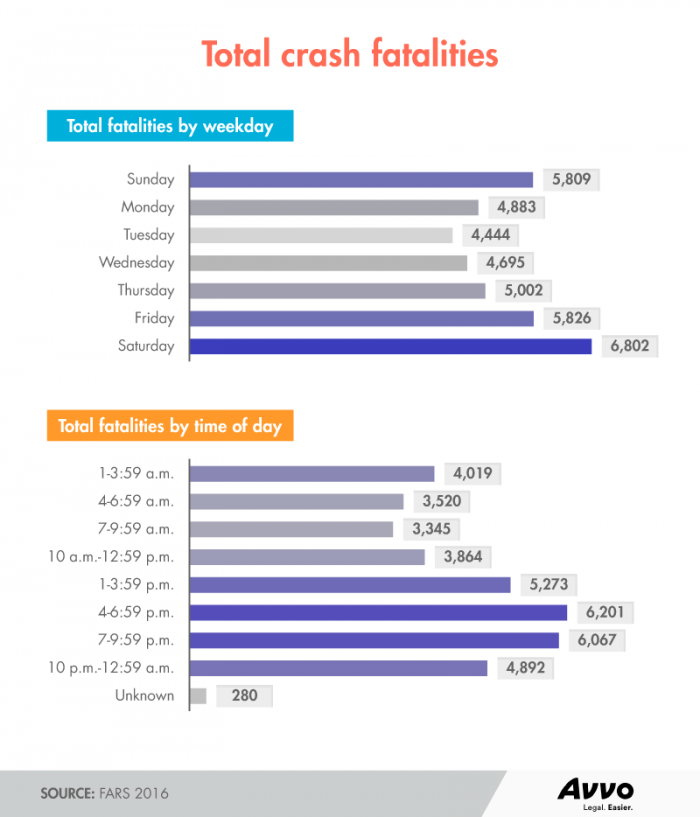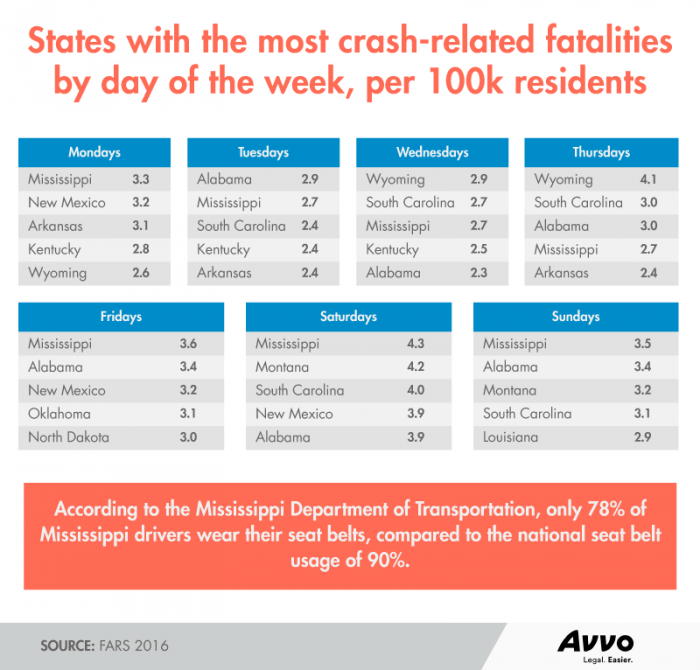When we hop in our cars and go about our day, we are likely thinking about everything we need to get done. There is the stress from work and impending deadlines; there is that often endless list of tasks we keep playing over and over again in our heads. We can, at times, be focused on everything but driving. The very act of driving can become monotonous over time, but that’s proving to be a dangerous thing.
By The Numbers
A new study from Avvo examined data from the Fatality Analysis Reporting System for 2016 to see how many crash-related fatalities happened across the United States. Depending on the time of day, month, and location, the data shows we are exposed to varying levels of risk during our travels.
“We were surprised to see car crash deaths are over 85 percent higher during the after work rush hour between 4:00 p.m. and 6:59 p.m. than they are during the morning rush hour between 7:00 a.m. and 9:59 a.m.,” explained Jeremy Reitman, Avvo’s Vice President of Organic Marketing.
“There could be a number of explanations why the majority of crashes occur during this time period,” said Special First Lieutenant and Traffic Safety Specialist Jim Flegel of the Michigan State Police. “When people all leave work around the same time, it leads to a large volume of traffic on the roadways and severe traffic congestion. Combine that with people in a hurry to get home, frustration, distracted driving, and impaired driving, and it is a recipe for traffic crashes to occur.”
The most dangerous times to drive are the late afternoon and early evening: 6,201 accidents occurred between 4:00 p.m. and 6:59 p.m., followed by 6,067 between 7:00 p.m. and 9:59 p.m. By contrast, the fewest fatalities (3,345) occurred during the morning hours between 7:00 a.m. and 9:59 a.m.
“It’s interesting to see this difference in our commutes and points to a driver’s state of mind after work,” Reitman said.
Weekend Worry
Weekends pose their own inherent risk with Saturday standing out in particular. Avvo’s study found that nearly 7,000 fatalities occurred on Saturdays in 2016, with Friday not far behind at 5,826 fatalities. The figures show the most dangerous time to travel is Saturday night after 10 p.m., but that risk extends into the early morning hours of Sunday, with 1:00 a.m. to 3:59 a.m. being equally as risky.
“The increase in fatalities on the weekends could be due to many different reasons,” Reitman said. “Our data doesn’t explore this specifically, but we can see various trends across the country where more drivers are on the roads during the weekends and also more careless and potentially reckless during this time.”
“Weekends are also a time when people have a tendency to drink alcohol and ingest controlled substances,” Flegel added. “This ultimately leads to extremely dangerous driving decisions and behavior.”
State to State
Some states fared worse than others with Mississippi being among the top five deadliest states on all seven days of the week. The absolute highest incidence of fatal accidents occurred on Saturdays in Mississippi, accounting for 4.3 crash fatalities per 100,000 residents, followed closely by Montana at 4.2.
“This could be because, according to the Mississippi Department of Transportation, only 78 percent of Mississippi drivers wear their seat belts compared to the national seat belt usage of 90 percent,” Reitman said.
Meanwhile, on days that had generally fewer road accidents, the safest states regularly clocked in below one fatality per 100,000 residents: On Mondays, New York, Rhode Island, and Massachusetts were tied for the safest at 0.6. On Fridays, Rhode Island represented the lowest number of the entire data set at 0.4.
Here at home, the Michigan State Police conduct several traffic safety initiatives throughout the year based on statistical data. Each post of the department is responsible for conducting these initiatives in their immediate area, which often focus on high density traffic crash locations. The Michigan State Police also participate in several other traffic safety campaigns including the Six State Trooper Project, Click It or Ticket, and Drive Sober or Get Pulled Over.
“In 1977, the Michigan State Police and Indiana State Police were the founding agencies for Operation C.A.R.E. – Crash Awareness and Reduction Efforts,” Flegel said. “The C.A.R.E. project was designed to reduce traffic collisions, injuries and fatalities through public information, education, and strict consistent traffic enforcement.”
Daily Driving
It’s important to understand – as best we can – how traffic generally flows during high volume times. Flegel notes that in heavy, stop-and-go traffic where cars are constantly merging, there is an increased risk for accidents. The difference between a collision and getting home safely might be an adjustment in our driving style – from offensive to defensive.
“Leave yourself an out,” Flegel explained. “Give sufficient space and distance between you and the traffic around you to give yourself time and distance to stop to avoid a crash.”
“Reckless and distracted driving, whether it be drowsy driving, or texting, or engaging in road rage, can be met with grave consequences – for you and for those you share the road with,” Reitman said.
According to the National Highway Traffic Safety Administration, distracted driving accounted for 3,450 deaths in 2016. Distracted driving was also the cause of the nearly 400,000 reported injuries during that same period.
“It takes on average 4.6 seconds to send a text message,” Flegel said. “At 55 mph, that is like driving the length of a football field blindfolded.”

Future Considerations
While Avvo’s study gives us some insight, it’s important to remember there is a certain level of risk each time we take the wheel – even during the times when crashes are statistically low. Perhaps the best takeaway from Avvo’s study is avoiding anything that would deliberately endanger yourself or others.
“First and foremost, seat belts save lives,” Flegel said. “If more drivers and passengers took that extra few seconds to put on their seat belts, it would drastically reduce the number of crash fatalities, not only in Michigan, but across the United States.”
“You can’t control other drivers, but under most circumstances, you can control your vehicle,” Reitman added. “We should all drive responsibly and stay alert when on the road.”
Carl Anthony is Managing Editor of Automoblog and resides in Detroit, Michigan. He studies mechanical engineering at Wayne State University, serves on the Board of Directors for the Ally Jolie Baldwin Foundation, and is a loyal Detroit Lions fan.
Safety Tips From The Michigan State Police
- Drive defensively.
- Limit distractions inside the vehicle.
- Obey all traffic laws and posted signs.
- Wear your seat belt each and every time.
- Be aware of your surroundings while driving.
- Never operate a vehicle impaired on alcohol or drugs.
- If your day involves alcohol, plan ahead and designate a sober driver.




